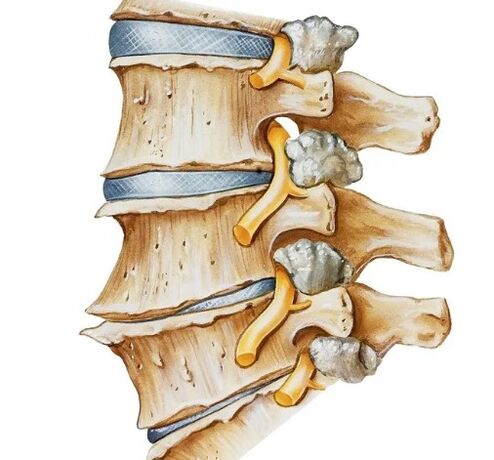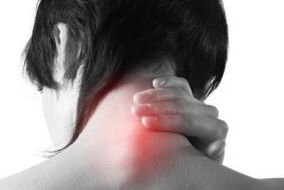existCervical Symptoms and Treatment of Osteocartilage DegenerationThey will vary depending on the type of cervical deformation associated with long-term physical, inflammation or psychological effects.

The disease is usually chronic and manifests itself in many clinical symptoms, which is caused by the squeeze of nerve roots and blood vessels squeezed out of the vertebrae. Their compression is due to wear or deformation of the intervertebral discs (reducing their height, loss of elasticity, deformation or rupture of the annulus). Cervical osteochondrosis is a common disease that occurs at any age after the age of 20.
The reason for pathology is the destructive changes in the spine. First, the discs change: their elasticity, strength and height decrease, their annular fibrous deformation, protrusions (the initial stage of vertebral hernia), and a hernia appears. All these changes cause bone growth on the vertebrae (bone plants), resulting in displacement and later the loss of cervical vertebrae migration. Since the spine is a flexible protective "case" of the spinal cord, destructive changes in the intervertebral disc and the loss of flexibility of the vertebrae are harmful to the nerve and vascular structures of the spinal cord. They are constrained by squeezed, displacement, which not only destroys brain circulation and innervation in the cervix and shoulder areas, but also destroys internal organs of the lower limbs.
The older the patient is, the more the discs are changed under the influence of age-related muscle weakness, long load on the spine, injury, slowing down physical exercise, forming improper posture, good pressure, increased tension in the neck, neck, shoulder straps, shoulder straps, spondylitis diseases, etc.

Due to its anatomy, the cervical spine is more likely to have pathology because its vertebrae is most mobile and is very close to each other. In addition, the cervical spine protects the muscles relatively weakly. Most commonly, changes occur on the disc of the most flowing 5. 6, 7 cervical vertebrae.
What are the symptoms of cervical osteochondrosis
Diversity and inconsistency of symptoms
Cervical Symptoms and Treatment of Osteocartilage DegenerationIt should be considered comprehensively with the type and severity of disc degeneration. The signs of cervical osteochondria are diverse and paradoxical because they depend on the localization and strength of the deformation process of the intervertebral disc, the particularity of compression or squeezing of nerve roots and blood vessels, and the location of muscles and organs and with the vlood.
Therefore, the complaints of patients are usually not directed at neurologists, but at other experts: cardiologists, therapists, otolaryngologists, optometrists, rheumatologists, etc. At the same time, neuropathologists can diagnose cervical osteochondrosis based on the results of brain and spine MRI, brain, ECG, etc.
Three sets of signs of impaired nervous system function
Experienced experts know that thirty different options are the combination of symptoms of cervical osteochondrosis. It is impossible to describe all the signs of this common disease, so let's move onThree ComplexesThe main symptoms of impaired certain functions of the central nervous system.
The first complex of basic symptoms is suitable for impaired functional parts of the peripheral nervous system. The department is represented by other elements leaving the brain and spinal cord and is divided into somatic and autonomous systems.
In short, the first symptoms of cervical osteochondrosis are presented in the form of various pain positioning. This does not mean that these signs are merely painful and often combined with other impaired body functions. But mainly - these are pains that occur on the neck continuously or regularly, the appearance of the patient is connected to hypothermia, prolonged stress or uncomfortable postures, weightlifting, sharp head turn.
Painful pain, shooting or similar to impact. Their positioning depends on the tension of certain muscles associated with the specific root of the nerve, which are squeezed by the vertebrae. Therefore, the pain will spread across the neck, the back of the neck, shoulders, one or both hands radiate to the chest - heart area, liver. In addition, when the head moves, there are complaints of tightening or cracks when the vertebrae in the cervical vertebrae and the stiffness of the head rotation movement.
In the acute attack of the disease, pain and cramps in the neck muscles force the patient's head to tilt and extend to one side. If the cervical nutritional formation is compressed and its blood supply is disturbed, pain may occur between the shoulder blades. This pain usually increases with physical and emotional stress.
Swelling, pale and cooling, numbness, rapid heart, heart pain, stenosis or dilation of the pupils, etc. are usually present. Symptoms of malnutrition changes in the shoulder joint may occur due to impaired shoulder innervation and spatial areas. The patient complains about pain and cannot lift his hands to the side and the stiffness of the shoulder joint.
The second complex of cervical osteochondrosis occurs due to impaired spinal cord function and is manifested by engine disease.
Diseases of spinal cord function are caused by the reduction of compression of the intervertebral disc, or damage to solid intervertebral discs and growth (bone plants). According to the mechanisms exposed to the spinal cord, the following dysmotic complexes were noted: stiffness of the occipital and cervical muscles, weaknesses in the arms and legs, increased tone of the leg muscles, reduced tone and weight loss; decreased temperature and pain sensitivity; strong fatigue of the legs and impaired coordination.
The third group of symptoms characterized the disorder of blood supply in the cerebral blood vessels and the pathology of the cranial nerves due to deformation of the cervical spine. Symptoms of vascular pathology.
Characteristics and symptoms of vascular disease:
- Neurotic conditions (irritability, desire, anxiety, fatigue, sleep disorder);
- fainting; headache and dizziness; nausea and vomiting;
- Noise and ringtones in the ears, hearing loss;
- Visual diseases (eyes, fog, flickering points, darkening of visual impairment);
- Glorious mining syndrome (sour throat, a feeling of foreign body, dryness, difficulty swallowing).
The symptoms of cervical osteocartilage degeneration are not clear and should be considered in the complex and depend on the pathological process of the spine.
Only qualified experts can handle the clinical manifestations of the disease, make the correct diagnosis and prescribe the correct treatment for the detected cause of the disease.
How to treat this disease
The symptoms of cervical spine and the treatment of osteochondria depend on the patient's condition, the severity of the disease, and the nature of the damage to the cervical spine.
In acute periods, hospitalization and medication may be required. Pain analgesics, novacaine muscle block, muscle relaxants are usually used to relieve muscle spasms; cartilage protective agents are used for nutrition of cartilage fabrics; sedative drugs that soothe the nervous system, B vitamins, and enhance neuromuscular conductivity. The treatment of cervical vertebrae is always very long and should be very complicated.
During remission, physical therapy methods (electrophoresis, ultrasound, etc. ) are widely used when acute symptoms are lacking, and therapeutic sports, massage, and non-traditional procedures, such as acupuncture, must be prescribed.

Many conservative treatments for osteochondrosis are known to prevent the progression of the disease. However, each patient needs to consider the stage of the disease, physical, gender and age characteristics. The purpose of treatment of cervical osteochondrosis is:
- Eliminate pain and edema at the inflammatory site.
- Relax the tension muscles in your neck.
- Release of clamping nerve roots.
- Blood circulation increases.
- Metabolism activation.
- Improve the function of the intervertebral disc.
Targeting complexes can prevent the occurrence of herniation and disc hernia.
For symptoms and treatment, osteochondrosis and treatment are not caused, and serious complications of the disease must be started in time.


























